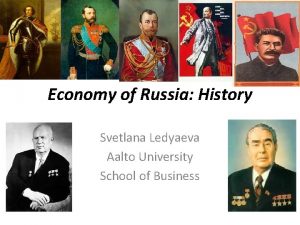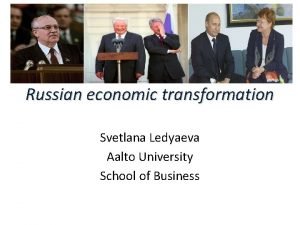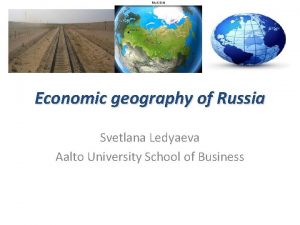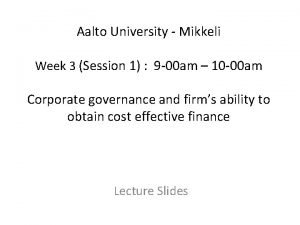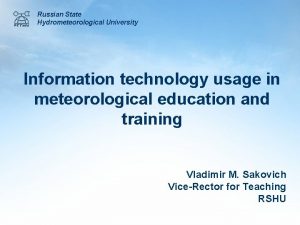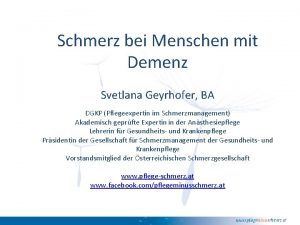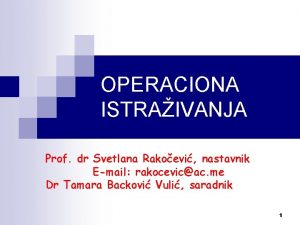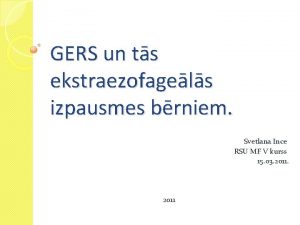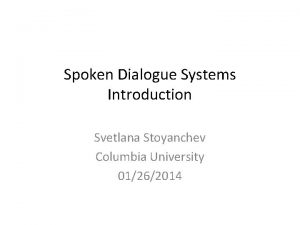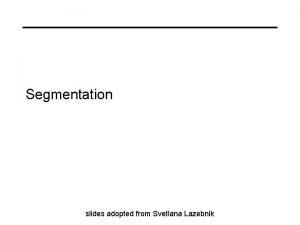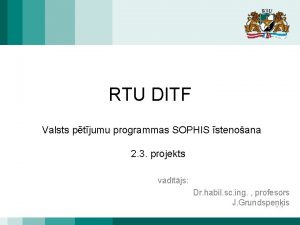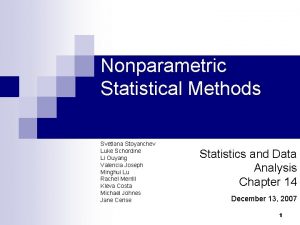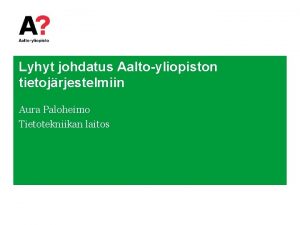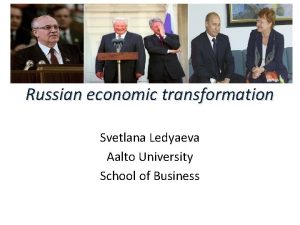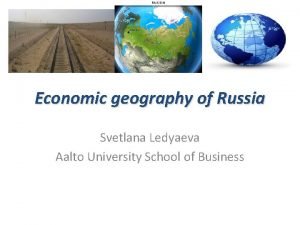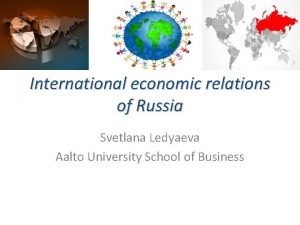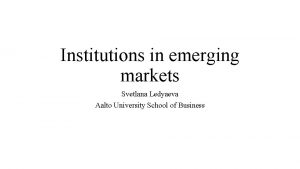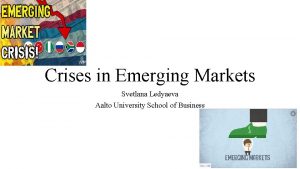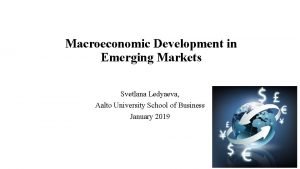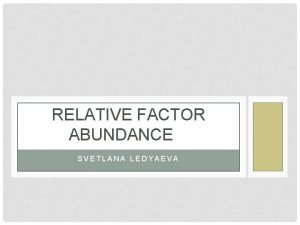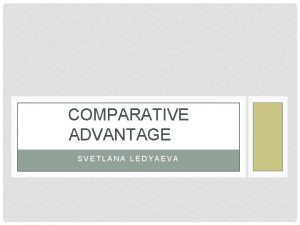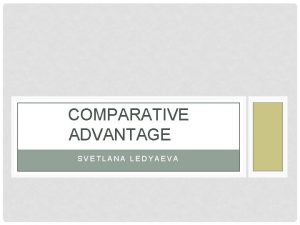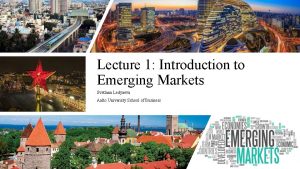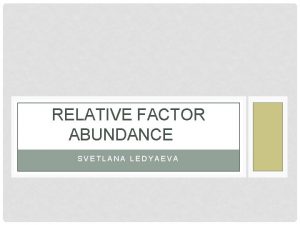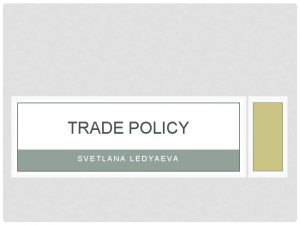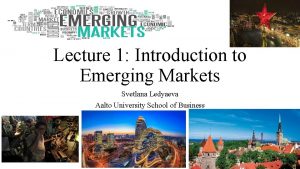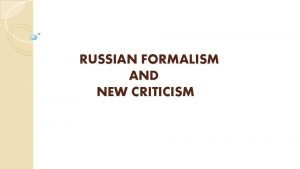Russian economic transformation Svetlana Ledyaeva Aalto University School






































- Slides: 38

Russian economic transformation Svetlana Ledyaeva Aalto University School of Business

Learning outcomes of this lecture Political and socio economic causes of Soviet Union collapse Russian economic transformation from central planning economy to a market one: Economic reforms and their consequences Economic development of Russia in recent years: Overview and comparison with other countries

The end of Brezhnev Era – beginning of the collapse of Soviet system Crisis in agriculture continued in the 1980 s: Necessity to buy grain in the international market: While the price of petroleum was high financing the purchase of grain from internal sources was possible. When the price of petroleum fell in the last 1980's => the Soviet Union needed to borrow the funds from Western banks to purchase the needed grain. => This severely restricted the international activities of the Soviet Union. HYPOTHESIS: HYPOTHESIS The reason for the decline in petroleum prices in the late 1980's: the Soviet Union invasion of Afghanistan. => Saudi Arabia increased its production of petroleum drastically (to punish SU) and consequently the price of petroleum fell.

Collapse of Soviet Union and the world price of oil

”Last days” of the Soviet Union 1982: Brezh nev dies and is replaced by KGB chief Yuri Andropov. 1984: Andropov dies and is replaced by Kon stan tin Chernenko. 1985: Cher nenkodies and is replaced by Mikhail Gor bachev.

Political causes of the Collapse of Soviet Union Eastern European countries (Poland, Hungary, Czechoslovakia) demanded reforms of communism or even did not want communism at all. Nationalism among Soviet satellite states, democratic opposition movements, and economic crisis. Mikhail Gorbachev`s role. Although his attempt to reform communism was rejected, his reformist positions as Soviet premier/head of government helped open the way for full fledged political dissidence.

MIKHAIL GORBACHEV (1985 -1991) His reforms has tened the end ofcommunism. anti alcohol cam paign. the poli cies of. OPENESS (RU: glas nost)and RESTRUCTURING (RU: perestroika). 1987: Signs super power treaty with US to begin scrap ping nuclearwarheads.

Collapse of the Soviet Union In just two years from 1989 to 1991: Ø The Berlin Wall fell. Ø The Soviet Union disintegrated. Ø Marxism Leninism was dumped unceremoniously on the ash heap of history. Ø Boris Eltsin becomes the first elected president of Russia in 1991.

Russia in economic transition: from 1991 onwards

Economic Transition of Russia Yegor Gaidar, the controversial architect of Russia's painful transition to a post Soviet market economy. First actual reform program was made in March 1992 (for IMF loan) => Washington consensus: Liberalization (price) Stabilization Privatization Structural reforms Yeltsin Russia (1991 1999) Putin Russia (2000 – present) versus

Washington consensus 10 prescriptions 1. Low government borrowing; borrowing 2. Redirection of public spending from subsidies toward broad based provision of key pro growth, pro poor services; services 3. Tax reform; reform 4. Interest rates that are market determined and positive (but moderate) in real terms; 5. Competitive exchange rates; rates 6. Trade liberalization; liberalization 7. Liberalization of inward foreign direct investment; 8. Privatization of state enterprises; 9. Deregulation; Deregulation 10. Legal security for property rights

Economic transition: stages (From Joseph Stiglitz (NOBEL PL), Globalization and its Discontents, 2002 Chapter 5) 1. Shock Therapy (Strongly voiced by US and IMF): • First round: Instantaneous price liberalization prices freed overnight in 1992. Resulting inflation wiped out savings. First mistake. Capital was used up. • Prices for natural resources were kept low. People got rich through rent seeking. – Buying oil in Russia and selling it in the West. • Second Round: Stabilization to reduce inflation. Tightened monetary policy by raising interest rates => huge drop in production output; increase of unemployment. • Third Round: Privatization – supposed to bring about positive restructuring of the economy. But this never occurred.

Hyperinflation in Russia, %/year 1000 943, 76 874, 62 822, 1 800 700 600 Inflation in producer prices 500 Inflation in consumer prices 400 337 Inflation in the wage level 307, 38 300 255, 9 200 236, 46 197, 41 64, 8 142, 2 47, 57 100 51, 21 0 1993 1994 1995 1996

Stages of privatization Pre privatization (commercialization) stage late 1980 s 1992 Mass Privatization (I) 1991 -1994 – Voucher privatization Cash privatization or Loans for Shares (II) 1994 -1997 – Sales of larger, high value enterprises to financial/industrial groups. – Loans for shares.

Voucher privatization Anatoli Chubais – responsible for Privatization in Russia. Each voucher nominal value was 10, 000 Russian rubles (175 USD): issued in 1992. Duration: 3 years. Every Russian citizen – one voucher for free. Vouchers could be used to buy shares of enterprises, voucher investment funds or could be sold.

Cash privatization Loans for shares: Government transfers to banks – for temporal control (5 years) – stock of shares of large companies. In exchange for low interest loans to the government due to 2000 (can be used for budget expenditures). During 5 years – the government must sell secured shares and return loans to banks or Ownership of many important enterprises was turned over to the banks. Economic reason – budget crisis.

Privatization (From Joseph Stiglitz, Globalization and its Discontents, 2002 Chapter 5) Privatization led to asset stripping/robbing, not wealth creation: • Pressured by US, World Bank and IMF to privatize quickly, state turned over its assets for a pittance and did so before effective tax system was in place. • Thereby created a powerful class of oligarchs and businessman who siphoned off funds and deposited them in Swiss bank accounts. • Russian government borrowed billions from IMF, yet, unable to pay pensions or welfare payments.

Structural reforms (From Joseph Stiglitz, Stiglitz Globalization and its Discontents, 2002 Chapter 5) Radical restructuring failure: • After 1989, GDP in Russia fell year after year. Recession has lasted over a decade. • 1990 1999: Russian industrial production fell by almost 60% and GDP fell by 54%.

The failed transition (From Joseph Stiglitz, Globalization and its Discontents, 2002 Chapter 5) Russia transformed from industrial country to natural resource exporter. Consensus that most people experienced a marked decline in their basic standards of living. Though: Main market institutions have been established. Public versus private sector (enterprises` statistics): 100 80 60 State 40 Municipal Private 20 0 1996 2001 2002 2003 2004 2005 2006

August 1998 crisis: background Reasons: v Declining productivity; v Artificially high fixed exchange rate between the rouble and foreign currencies to avoid public turmoil; v Chronic fiscal deficit. Reasons according to the IMF: (1) weak economic fundamentals, especially in the fiscal area; (2) unfavorable developments in the external environment, including contagion effects from the Asian financial crisis and falling prices for key export commodities such as oil; (3) Russia`s “vulnerability to changes in market sentiment arising from the financing of balance of payments through short term treasury bills and bonds placed on international markets”.

August 1998 crisis: Chronicle August 13 th, 1998: The Russian stock, bond and currency markets collapse. August 17 th, 1998: • A significant devaluation of the ruble; • A default on short term Treasury Bills known as GKOs, as well as longer dated ruble denominated bonds named OFZs; • A 90 day moratorium on payments by commercial banks to foreign creditors. September 2 nd, 1998: The Russian Central Bank’s removes the currency corridor and makes the ruble a freely floating currency sharp depreciation of the ruble high inflation social unrest.

August 1998 crisis: some data facts

Part 2: Russia`s recent economics development: brief overview

Resent economic trends in Russia • The Russian economy has grown impressively since 1999; • One of the fastest growing economies in the world in recent decade before 2014. Ø 1999 2008 – Average growth rates 7% Russia has never had a decade like this. • Improvement in the standards of living of the average Russian citizen; • Dramatic improvement in fighting poverty => explains Putin`s popularity. • Economic stability. Ø Putin centralized government, reduces accountability and limits freedom. Ø But public is satisfied with income growth.

What is behind the Russian economy rapid growth in recent years before 2014? Macroeconomic policy Conservatism in the area of expenditures Formation of stabilization/reserve fund Protection of the Central Bank from lobbyists of inflationary financing (from Konstantin Sonin livejournal)

What is behind the Russian economy rapid growth in those years? Energy prices

Crisis of 2009 • Oil prices and financial squeeze/compression. • Plus few policy mistakes (e. g. delayed devaluation). • Recovery in 2010 2011 – growth of 5%. • Stagnation – structural nature or cyclical nature? Structural nature; External problems – global slowdown. (From Sergei Guriev public lecture)

Annual percentage growth rate of GDP at market prices based on constant local currency. Aggregates are based on constant 2010 U. S. dollars. 15, 0 10, 0 7, 3 6, 4 5, 1 5, 0 4, 7 7, 2 8, 5 6, 4 5, 2 4, 5 4, 1 5, 0 2, 8 3, 6 7, 8 10, 0 12, 6 20, 0 0, 7 5, 3 8, 7 15, 0 1, 5 2, 3 0, 2 1990 1991 1992 1993 1994 1995 1996 1997 1998 1999 2000 2001 2002 2003 2004 2005 2006 2007 2008 2009 2010 2011 2012 2013 2014 2015 2016 2017 2018 3, 0 5, 0 3, 7 1, 8 1, 4 0, 0 5, 3 14, 5

GDP growth rates in 2007

GDP growth rates in 2009

GDP growth rates in 2013

GDP growth rates in 2014

GDP growth rates in 2017

Inflation, consumer prices (annual %) 25, 0 20, 0 15, 0 10, 0 20, 821, 5 15, 8 13, 7 12, 7 10, 9 9, 7 9, 0 15, 5 14, 1 11, 7 6, 9 5, 0 8, 4 5, 1 6, 7 7, 8 7, 0 3, 7 2, 9 0, 0 2001 2002 2003 2004 2005 2006 2007 2008 2009 2010 2011 2012 2013 2014 2015 2016 2017 2018

Inward FDI into Russia, million USD 80000 74783 70000 69219 60000 55874 55084 50588 50000 43168 40000 36583 32539 30000 27886 22031 20000 10000 8785 6853 0 2007 2008 2009 2010 2011 2012 2013 2014 2015 2016 2017 2018

Russia in the world: developing, transition or developed? According to IMF report 2011: Russia belongs to a group of emerging and developing economies. BRIC: Brazil, Russia, India, China: are all deemed to be at a similar stage of newly advanced economic development. Developed: highly educated population; Russia is one of the world's five officially recognized nuclear powers. Developing: polarization of wealth and poverty; high dependence on natural resources.

Russia is an emerging market What is emerging market? Countries with underfunded growth opportunities with problems; Recent integration with global capital market; Poorer than those in the developed world but that has capital markets (stock and bond markets) accessible to international investors; Less developed country but one that has adopted the institutional, legal, and financial structures; Sufficiently open to the global economy; Platform for sustainable economic growth

Russia and other emerging economies Emerging economies Developing countries BRICS: Brazil, Russia, India, China, South Africa Transition countries Post socialist, Post Soviet republics (Russia)
 Svetlana ledyaeva
Svetlana ledyaeva Svetlana ledyaeva
Svetlana ledyaeva Svetlana ledyaeva
Svetlana ledyaeva Russia gini coefficient
Russia gini coefficient Svetlana ledyaeva
Svetlana ledyaeva Svetlana ledyaeva
Svetlana ledyaeva Aalto university school of engineering
Aalto university school of engineering Aalto mikkeli
Aalto mikkeli Aalto university mikkeli
Aalto university mikkeli Russian state university of tourism and service
Russian state university of tourism and service Russian state hydrometeorological university
Russian state hydrometeorological university Economic growth vs economic development
Economic growth vs economic development Economic growth vs economic development
Economic growth vs economic development Economic systems lesson 2 our economic choices
Economic systems lesson 2 our economic choices Uiuc texture dataset
Uiuc texture dataset Svetlana geyrhofer
Svetlana geyrhofer Dr svetlana lanku
Dr svetlana lanku Dr zeljko boskovic neurolog
Dr zeljko boskovic neurolog Prof dr svetlana stanisic
Prof dr svetlana stanisic Svetlana berdyugina
Svetlana berdyugina Svetlana drachova
Svetlana drachova žitorađa ceca
žitorađa ceca Dr svetlana stanisic
Dr svetlana stanisic Svetlana rakocevic
Svetlana rakocevic Fundoplikācija
Fundoplikācija Svetlana gurvich
Svetlana gurvich Bho university
Bho university Svetlana stoyanchev
Svetlana stoyanchev Svetlana stoyanchev
Svetlana stoyanchev Svetlana lazebnik
Svetlana lazebnik Svetlana berdyugina
Svetlana berdyugina Svetlana otto
Svetlana otto Svetlana berdyugina
Svetlana berdyugina Swsu
Swsu Svetlana stoyanchev
Svetlana stoyanchev Svetlana polman
Svetlana polman Sajt netoperacije 4
Sajt netoperacije 4 Svetlana smirnov
Svetlana smirnov Aalto eduroam
Aalto eduroam
